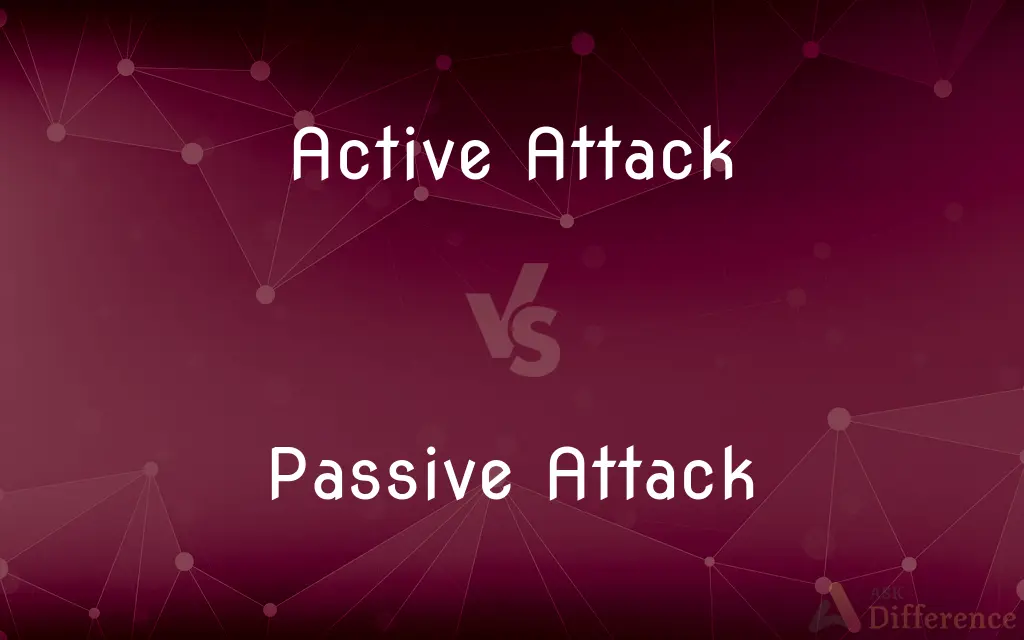Active Attack vs. Passive Attack — What's the Difference?
By Tayyaba Rehman — Published on November 23, 2023
Active Attack involves altering system resources or data, while Passive Attack involves intercepting data without alteration.

Difference Between Active Attack and Passive Attack
Table of Contents
ADVERTISEMENT
Key Differences
Active Attack refers to an assault on a system where the primary intention is to modify or alter the system's resources, data, or operations. In an Active Attack, the attacker might delete files, inject malicious code, or disrupt system functionality. The consequences of an Active Attack are generally immediate and can have devastating effects on the system's integrity, confidentiality, or availability.
On the other hand, a Passive Attack involves the unauthorized interception and monitoring of data transmissions without making any alterations to the data itself. The primary objective in a Passive Attack is typically to gather information for later use, such as eavesdropping on conversations or copying sensitive data. Unlike Active Attacks, Passive Attacks are often stealthy in nature, aiming to operate without detection to continuously collect information.
Active Attacks are blatant intrusions that leave traces and are generally easier to detect. They often raise alarms or leave signs of a security breach. Conversely, Passive Attacks are subtle, stealthy, and may go undetected for extended periods, since they don't involve any alteration of the data or system. They merely "listen" or "observe."
To illustrate further, an example of an Active Attack would be a hacker trying to inject a virus into a system or launching a denial-of-service (DoS) assault. In contrast, a Passive Attack example might be a cybercriminal using a sniffer tool to capture and read network packets without tampering with them. Both types of attacks have distinct goals, methods, and consequences, with Active Attacks causing immediate disruption and Passive Attacks focusing on silent data gathering.
Comparison Chart
Goal
Alteration of data/system
Data interception without alteration
ADVERTISEMENT
Detectability
Easier to detect
Harder to detect
Method
Disruption, modification
Eavesdropping, monitoring
Immediate Impact
Often has immediate consequences
Silent, for information gathering
Example
Injecting malware
Using a sniffer to capture network packets
Compare with Definitions
Active Attack
An intrusion to modify system data.
The hacker's Active Attack corrupted the database records.
Passive Attack
Unauthorized interception of data.
The spy's Passive Attack captured confidential communications.
Active Attack
Assault that disrupts system operations.
The denial-of-service was an Active Attack that brought down the website.
Passive Attack
Operates without detection for information collection.
The Passive Attack used a sniffer to log all network traffic.
Active Attack
Directly impacts system integrity.
The Active Attack compromised the security settings of the firewall.
Passive Attack
Stealthy monitoring without data alteration.
With a Passive Attack, the attacker recorded the keystrokes silently.
Active Attack
Aimed at injecting malicious code.
The Active Attack placed a backdoor in the application.
Passive Attack
Aimed at gathering information covertly.
The Passive Attack collected users' credentials without raising alarms.
Active Attack
Seeks to alter or delete files.
The malware's Active Attack deleted essential system files.
Passive Attack
Does not disrupt or modify system functionality.
The Passive Attack observed patterns but didn't interfere with the operations.
Common Curiosities
Which attack involves data interception without alteration?
A Passive Attack involves intercepting data without making alterations.
What might a cybercriminal aim for with a Passive Attack?
With a Passive Attack, a cybercriminal often aims to gather sensitive information covertly.
Does an Active Attack always leave traces?
While not always, Active Attacks often leave traces or signs due to their disruptive nature.
What's the main goal of an Active Attack?
An Active Attack seeks to alter, disrupt, or modify system resources or data.
Is a Passive Attack easily detectable?
No, Passive Attacks are stealthy and often hard to detect as they don't alter data.
Which is more blatant: an Active Attack or a Passive Attack?
An Active Attack is more blatant as it often causes immediate and noticeable effects.
Is eavesdropping an example of an Active or Passive Attack?
Eavesdropping is an example of a Passive Attack.
Can a Passive Attack disrupt system operations?
No, a Passive Attack focuses on monitoring without directly disrupting system operations.
Can Active Attacks compromise system confidentiality?
Yes, Active Attacks can compromise system confidentiality, integrity, and availability.
How might an attacker use a Passive Attack on network traffic?
An attacker might use sniffing tools in a Passive Attack to capture and analyze network packets.
Why might Passive Attacks be considered more dangerous than Active Attacks?
Passive Attacks might be considered more dangerous due to their stealthy nature and long undetected periods.
What's a typical sign of an Active Attack on a website?
A denial-of-service (DoS) assault, causing website unavailability, is a sign of an Active Attack.
Are Active Attacks always malicious?
While typically malicious, some Active Attacks, like penetration testing, are done for security assessments.
How can organizations defend against Passive Attacks?
Organizations can use encryption and monitor network traffic to defend against Passive Attacks.
Share Your Discovery

Previous Comparison
Mole Fraction vs. Weight Percent
Next Comparison
Tensile Strength vs. Yield StrengthAuthor Spotlight
Written by
Tayyaba RehmanTayyaba Rehman is a distinguished writer, currently serving as a primary contributor to askdifference.com. As a researcher in semantics and etymology, Tayyaba's passion for the complexity of languages and their distinctions has found a perfect home on the platform. Tayyaba delves into the intricacies of language, distinguishing between commonly confused words and phrases, thereby providing clarity for readers worldwide.
















































